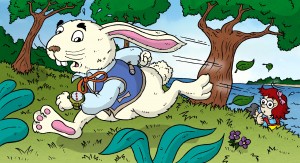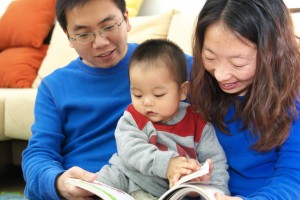(Applicable to French, Chinese, English and Any Other Language)
[Note: In the previous two posts we covered several important need-to-know facts about young children learning languages. Please go back to post 1 and post 2 before reading today’s new information if you haven’t done so already.]
As you may have heard many times “reading is fundamental.” Indeed, reading is so fundamental that it is at the very core of most other learning endeavors.

BUT we are not going to be talking about reading per se in this blog…
Instead, we are going to focus on reading aloud as a phenomenal tool to achieve many desirable effects in a relatively easy, inexpensive, and time effective fashion (all you need to do is find the right book and start reading! Isn’t that much better than a $300 to $400 software package?).
Why Is Reading Aloud So Effective for Young Language Learners (and for Language Learners of All Ages) Even if It Is Only 15 Minutes a Day?
You can probably guess the answer from what I explained in previous blogs …
Serving fluent language to your kids and doing it as early as possible is an essential stepping stone to help them become highly proficient. I will keep hammering away at this until it’s engraved in your brain 🙂
For example, when reading aloud you:
- Expose your children to the sounds and rhythm of fluent language as it flows naturally. Every language has a special melodic ring. This is called “prosody” and children are great at picking it up.
- Expose your children to the patterns of the language. Every language is formed by bricks or building blocks that you can rearrange in different ways as long as they are consistent with the building. This is pretty much what grammar is, and again, children are great at sensing these patterns (and believe me, it is so much easier than trying to learn the rules later in high school!).
- Expose your children to hundreds of words in context. Many of them will be everyday words, and many others will be less frequent or even rare. Using a combination of everyday and rare words is great nutrition for the brain when the goal is high proficiency in a language. Children books already come packed with a healthy mix of words (but you have to choose the right books).
I am going to share two additional reasons that should be at the top of everybody’s list but most people do not even think about (and we end up paying for this mistake big time!). When you read aloud you also:
- Create excitement about learning the new language (shouldn’t motivation be our #1 priority?). Babies, toddlers, preschoolers and young children LOVE to cuddle with you or sit around you as you read a book to them. Their brain automatically links this very positive experience to that of learning the new language – and this happens even if they may not understand much of what you say! (Talk about easy motivation! Granted that this is much easier with a two year old than with a fourteen year old, another benefit of starting early.)
- Utilize the children’s linguistic brain to its maximum potential. Remember what I told you about Maria Montessori’s revolutionary idea of preparing “the environment” (including practices) so that the exploration and the learning came from within the child? When you read aloud to your children, their brain will immediately fire up and start searching for cues to understand this language. And the good news is that young children have the very best brain for doing precisely that.
Your Goal: Build Oral Skills
You may have noticed that I am talking a lot about the oral part of reading aloud and not so much about the reading aspect of it.
As mentioned earlier, your primary goal at this point is not so much to help your children develop reading skills (although you are laying a good foundation for that as well).
Instead, at this very early stage of language learning, your main goal is to help your child develop listening comprehension as well as oral skills. So don’t worry about phonics and decoding just yet! As a matter of fact, children who are read to a lot already have a leg up on all things reading, and let me tell you, the oral component is critical for this.
In summary, there two key takeaways for today’s post:
- One is that reading aloud allows you to expose children to high quality fluent language in context – and remember, with practice children can piece it all together.
- The second is that your main goal for now should be to develop listening and oral skills in a fun and interactive way.
In the next posts we will cover things such as type of books by age, how to read these books, strategies for monolingual or mixed households, fun activities to reinforce the vocabulary learned through the book, and many other things, so make sure to check the blog often. The best way to keep posted is to opt in to my e-mail list. [To opt in to my list, just write your name and e-mail information on the right sidebar where it says, “Sign Up for Language Learning Tips”]
Best,
Ana Lomba
P. S. Talking about reading aloud, make sure to check my collection of bilingual e-storybooks in Spanish, French, and Chinese with English on this website (also available as iPad apps from the iPad App Store).
P. S. S. If you are on Facebook, make sure to “like” my Ana Lomba Early Languages page (and thanks!)
P. S. S. S. And while you wait for the next blog you may want to take a look at the “Language Challenge 180” hosted by Multilingual Living. Better to learn in company, don’t you think? At this point there are over 650 families that have joined the challenge. Why not join the fun!
******
Ana Lomba is changing the way people think about and interact with young children learning languages. Her Parents’ Choice award-winning books, lively songs, games, stories, and mobile applications are quickly becoming favorites with teachers and parents who want to nurture young children’ inborn language abilities. Key to the success of Ana’s break-through method is a focus on the family as the ideal environment for early language learning – even her signature curriculum for language programs is built with parents in mind. Ana has taught toddler, preschool, elementary school, and college-level Spanish courses, and held leadership positions with some of the most influential language organizations in the US, including ACTFL, NNELL and FLENJ. After graduating with a law degree from Spain, her native country, Ana pursued graduate studies at Binghamton University, Princeton University, and NYU.



